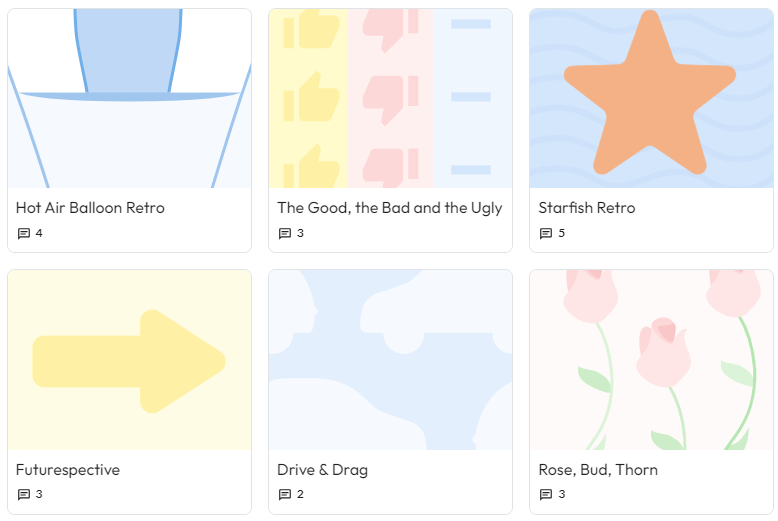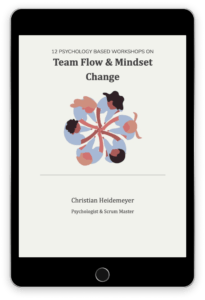Retrospectives are one of the most important meetings for agile teams to reflect on and further develop their collaboration. The frequency usually varies between weekly and monthly, and there is a fixed block in the team's calendar to ensure that this meeting will take place.
It can happen from time to time that the planned time window is not available due to external factors, such as ad-hoc appointments or deadlines. In these cases, we advocate doing a short retrospective rather than simply skipping it.
The Scrum Guide on the duration of a retrospective
The Scrum Guide suggests that you should free up 3 hours for a retrospective - when you have a one-month sprint rhythm. In practice, this time window is usually not feasible. In our experience, most teams block between 60 and 120 minutes for their retrospectives.
💡 New analysis of 30,000 retrospectives
Short retrospectives with a duration between 30-45 minutes are even the ones with the best rating (8.5/10) by participants!
tips for short retrospectives
What can you do when things have to be fast? Here are our tips for a quick retrospective that will help you move forward.
Tip 1 for your short retrospective: DO NOT skip check-in
A common mistake is to simply skip the check-in as a first step and get straight to the point - after all, the productive part of the retrospective only comes after the check-in/warm up right?
That's a misconception. The check-in and “setting the stage” is an essential component of the retro, and is far too important to the process, that you should even think about skipping.
Those who do not check-in will have a hard time actively engaging the team during the process of the retrospective, as it is a prerequisite for productive discussions.
For example, the check-in can simply be a basic open question, that each team member answers after each other in 2 to 3 sentences. For example:
- What is your high- or lowlight from last week?
- On a scale from 0 for bad to 10 for super - how are you feeling right now?
Otherwise, there are various check-in generators that you can use. The few minutes spent on a check-in are worth it, I promise.
Tip 2 for your short retrospective: collect feedback in advance
The data gathering phase of a retrospective is often the part that takes up the most time - whether you are just using sticky notes or online tools.
Here, teams who have collected feedback and topic suggestions beforehand are at a great advantage. This way, you can have all data ready for the retrospective and go straight to the topic discussion without needing to make time for individual brainstorming. For example, you could send out a survey before the retro, create a page in Jira where topics are collected, or simply ask for feedback via e-mail for the short retrospective.
As a tool for retros, on Echometer you can, for example, ask for retro feedback on both psychological behavior anchors and open questions ("Keep, Stop, Start" & Co.). The answers received are automatically compiled for the upcoming retrospective and ready for presentation in an interactive team development workshop.
Most Agile Coaches and Scrum Masters run in circles...
...fixing superficial symptoms. Time to use psychology to foster sustainable mindset change.
Tip 3 for your short retrospective: Discussing action items in breakout sessions
Another part of the retrospective is the discussion about deriving measures. While the prioritization of the topics should definitely be done together during the retrospective, the discussions on the definition of these measures can be clarified in small groups outside of the retrospective - for example in breakout sessions.
If your team agrees on what the most important problems are at the moment, you can form a “task force” consisting of 2 or more people, who will then discuss the topics among themselves, then share the results with the rest of the team.
Measures like this can then be recorded in the retrospective as follows:
- Topic X: Klaus and Greta work out a concept for a solution and share it with the team before next Tuesday
- Topic Y: Gundula and Kevin discuss whether it might be worth pursuing solution Z and share their result with the team by tonight
Tip 4 for your short retrospective: Health Check Retros
- Specific statements are presented (see below for examples).
- Each team member evaluates the statements anonymously on a survey scale – how much do you agree from 1 to 7?
- Optional: The results are discussed. Positive and negative examples are collected that might explain the results. This part potentially takes a long time.
- Prioritization is now carried out, with each team member voting anonymously as to which of the statements require the greatest need for action.
- An action item is only put down for the statement that has the most votes - not the "second most voted" one - to save time.
Note: This retrospective format asks for agreement with the given Health Check items on a scale.
- Appreciation: My colleagues appreciate my contribution to the team.
- Team Spirit: There is a trusting working atmosphere in our team.
- Transparency: Everyone in my team knows who is currently working on what.
- Recovery & Breaks: I have enough room for breaks in which I can draw new energy.
- Meeting culture: Our meetings are well structured, yet leave room for creativity and new ideas.
- Support: In my team, each team member passes on their individual knowledge and experience.
Tip 5 for your short retrospective: try it Echometer some day
A good support to keep your retro short are good retro tools (see 7 best retro tools comparison). They can do some of the work for you – including timeboxing or prioritizing feedback.
In particular, I want to mention the retrospective tool Echometer that I myself helped to develop. It combines insights from psychology with agile best practices to get the best out of team health checks & fun retrospectives - to help to grow your team.
We are giving you specific advice in the tool on how to derive good action items – and it can be used both online (remotely) and offline (more on this here: the Best Retrospective Meeting Tool).
You can use this button to quick open the 'lean coffee' retrospective and invite a team via a link (there are more than 30 other retrospectives ideas available):
When you get to the end of the retro, if you want to, you can create a free account to save your results.
Learn more on our tool in general right here or start for free.
How short can you make a retrospective?
Using the aforementioned tips, a retrospective can be completed (in some individual cases) in about 30 minutes. Of course, this also depends on the choice of method. There are many retrospective methods that are not feasible in such a short time.
If the team attaches great importance to making the retrospectives as effective as possible, it can make sense to agree on a structured model in the team, according to which the retros are designed.
At Echometer, we provide a kit that enables you to create varied retrospectives within a structured process. The process can, of course, be adjusted flexibly if that's what you want - and also backs your retrospective with psychological knowledge! Feel free to ask us for a free demo account if that sounds like something for you.
Nevertheless, keep in mind that you should always block at least 60 minutes in the calendar for the team retrospective (depending on the team size, more if necessary), even if it can occasionally be faster.
Final note
If it is already clear in advance that even the minimum time of 60 minutes recommended is not going to be possible: think about whether a postponement of the retrospective might be the better solution. At the very least: postponed does not mean canceled 😉
If you are searching for fun retrospective ideas, check out our post on 54 Kickass Retrospective Ideas for Agile Teams (including the Mario Kart Retro & the Team Morale Health Check).
By the way, if you are still looking for a suitable retro board (with 60+ agile retrospective formats), this post can help you: Comparing the 6 best retrospective boards
Most Agile Coaches and Scrum Masters run in circles...
...fixing superficial symptoms. Time to use psychology to foster sustainable mindset change.











